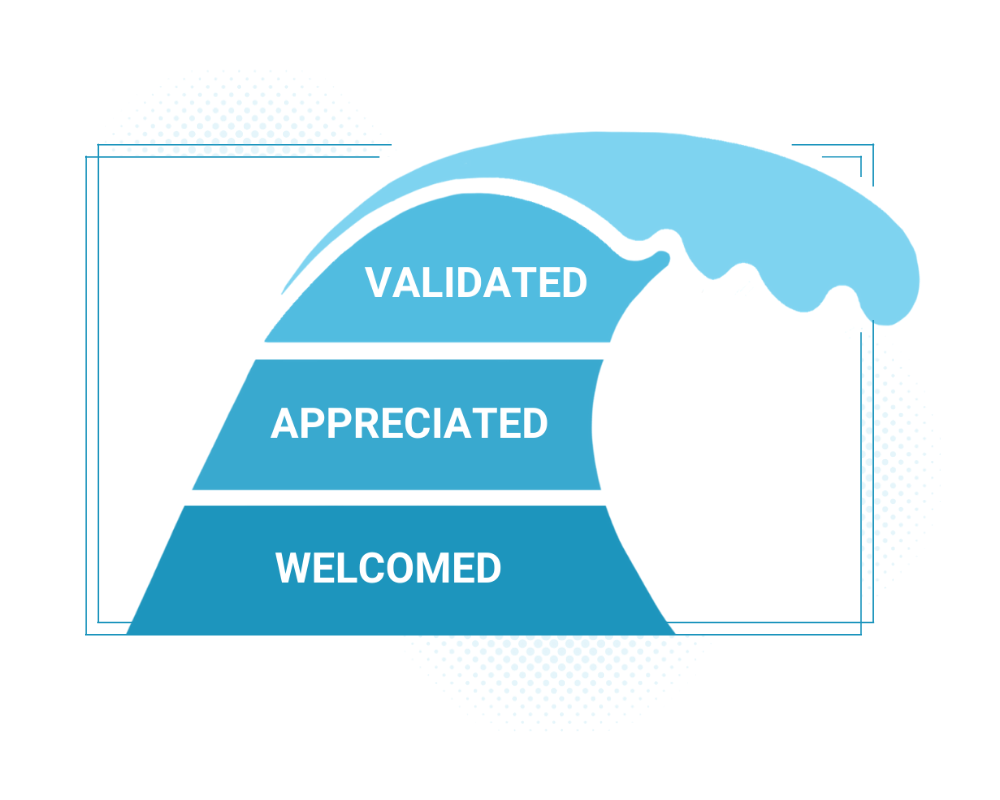Regardless of how great you are at a job, you — or someone who works for you — will, at some point, stumble. It’s inevitable. And, regardless of how well you’ve performed in the past, or are currently performing for other customers, there’s one key word you need to remember when it comes to turning unhappy customers back into superfans of your brand and your products or services: Validation.

This blog is the fourth in my series on The Superfan W.A.V.E., which is an acronym to help you remember to be great in all of your customer-facing interactions. Today’s post is all about the “V” in “W.A.V.E.” or Validation. But, before I tell you why it’s important, take it from Oprah Winfrey:
I’ve talked to nearly thirty thousand people on this show, and all thirty thousand had one thing in common: They all wanted validation…They want to know: ‘Do you see me? Do you hear me? Does what I say mean anything to you?’…Try it with your children, your husband, your wife, your boss, your friends. Validate them. ‘I see you. I hear you. And what you say matters to me.’
Although Oprah’s words are true in a personal sense, they’re also true when it comes to your customers. Let’s talk about why and how validating unhappy customers’ concerns can turn them into lifelong superfans of your company.
The Importance of Validating Customers’ Feelings & Concerns
Have you ever had to express dissatisfaction to a customer service representative? If you have, you already know how unhelpful it is to hear something like, “We’ve had ten thousand happy customers, and no one has had this issue before.” in response to your concern.
In situations like these, nothing is worse than hearing about someone else’s experience, because it does not matter to you. You’re there to have your problems solved and improve your experience. Likewise, when you’re approached by unhappy customers in your own business, their experiences are the only ones that matter. Don’t conflate one person’s experience with anything else, including your brand, your products, or the experience of other customers. Additionally – and perhaps more importantly – don’t assume that because this is the first time you’re hearing this particular complaint, other unhappy customers haven’t experienced this issue, too. All it means is that one customer took the time to share their concern rather than put up with it.
With these “don’t”s in mind, the best way to handle customer questions or complaints is to validate their concerns. It may sound ambiguous, and validating customer concerns can come in many forms as long as you’re actively listening, asking questions, learning from the experience, and thanking them for their time.
Often times, making customers feel validated is simply showing that you take them seriously. What may seem like common sense or an easy fix to you can be confusing or intimidating for someone else. Through validation, however, you can show customers that you understand where they’re coming from. You’re not there to judge, just to own your mistakes and work together to make things right!
How To Make Your Customers Feel Validated
Like the other aspects of the W.A.V.E. – making customers feel welcomed, appreciated, and engaged – validating customer concerns is largely about planning. All customer service varies a little, simply because of each individual’s preferences, but in the background, everyone on your team should be on the same page. When a customer is concerned about price, you should know what to say. When a customer is unhappy about a store policy, you should know how to explain the changes. In part, it’s about being able to calmly and clearly solve the problem, but it’s also important to outline your expectations for your team. That way, no matter which team member a customer contacts for help, they’re ensured the same empathic, patient, and validating response.
To start crafting a customer retention and validation strategy, start with your own experience. Think of a time when you were dissatisfied with a service or product, contacted the company’s customer service about it, and came away from that interaction feeling validated enough to recommend that company to your friends. Break it down step by step, and answer the following questions:
- What did the company do to make you feel validated?
- What steps did they take to make amends?
- How can you implement those same steps into your business’ customer care process to make your own customers feel validated?
From there, for each of these answers, think about how you can implement these strategies in your own business. Things like empathy, attention to detail, and a dedication to customer satisfaction work in every industry and, combined, they’re a sure way to boost customer retention. Plus, if you need some ideas to kickstart your brainstorming, below are three that are sure to do the trick.
Remember that the customer always has a right to share their feedback.
First, remember that the customer isn’t always right. In many cases, a customer complaint starts with miscommunication or a simple misunderstanding. In this case, all the customer needs is an explanation. However, in all cases, even if they’re mistaken, every customer has the right to share their grievances. Who knows? Maybe there’s a part of your signage or website that’s creating the miscommunication, and you don’t even know it yet. When that’s the case, sometimes the only way to find out is because of a customer complaint.

On the flip side, if there isn’t an easy fix, it’s also perfectly okay to just let unhappy customers vent. They could be dealing with challenges in their personal life or problems at work. Maybe they’re just a negative person and tend to look at everything in a bad light. Either way, showing empathy and validating their frustration will always be a good choice in the long run. Even if the answer is firing them as a client or having to refund their purchase, taking the high road on your end makes it much less likely that they’ll share their not-so-nice opinions with their network. There’s also a chance that they just needed one thing to go right and, by solving their problem with your business, you helped them approach their next purchase with a better outlook.
Side Note: Part of a good customer retention strategy involves regularly “checking in” within your team to see how you can be doing better, based on everyone’s customer-facing experiences. But, it’s also important to check in on a human level, especially after someone takes a verbal lashing they didn’t deserve. After all, employees will only be able to treat customers as well as you treat them. Period.
Have a documented plan for handling big mistakes.
The second part of customer retention is one we’ve already mentioned: Have a plan. More specifically, a plan in writing. Just as companies have Crisis PR plans for their reputations, you should also have a Crisis Patron Relationship plan for your professional relationship with customers. That way, for every common “unhappy customer” scenario you can think of, you’ll have a strategy for saving the relationship.

According to John Rood, for example, the founder of Next Step Test Preparation, his plan is all about being honest and apologetic and holding himself (and his employees) accountable. To hear him tell it, “As we talk, I write out an email with specific action steps and due dates. That way the customer can see the specific steps for addressing their concerns. I tell them frankly that if we miss dates or deliverables, we’ll offer a full refund.”
Alternatively, if you can’t do anything immediately, demonstrate how you and your team are working to improve in the future. Brennan White, co-founder and CEO of Cortex, for example, explains:
When clients want to leave, we often win them back right away by letting them in on the product roadmap and the related timeline. This glimpse into the future gives them (a) a feeling of importance due to the asymmetrical information, and (b) a clear path by which they can determine if our product will become a better fit for them over time. Upwards of 80% of the time, this is enough.
Likewise, your own customer retention plan should cover the past, present, and future. Ask yourself “What mistakes have we made already?” and “What can we do immediately to fix those mistakes or make them bearable?” Then, build a plan for the future, so you don’t make the same mistake twice.
Give employees a dollar amount, under which they can automatically correct problems.
Lastly, while there will inevitabley be some tough experiences with unhappy customers, most grievances will likely be small. Think expired milk on a grocery store shelf or a customer that missed a sale by a matter of hours. In these situations, it’s not worth anyone’s time to turn the problem into a full-blown discussion. Your team members’ time is worth more than that, not to mention your own.

In small situations like these, give your team members an “allowance” of sorts, for automatically righting small wrongs. Maybe it’s a specific set of common issues that can be swiftly and easily handled. Maybe it’s a specific dollar amount that they can discount customers, if the situation demands it. For more details about how to set this limit and when to use it, see my previous guide to the three important qualities of exceptional customer service.
Ultimately, when we feel validated, we feel like we matter, whether we’re in a business setting or a personal one. We feel like we’re part of something bigger than ourselves, like we’re part of a community. Looking at the Superfan W.A.V.E., validation – and this sense of belonging – is a precursor to engagement, the last component of customer service and creating superfans in your business.
To learn more about making customers feel engaged, check out the next and final step in my Superfan Series, “Connecting With Your Customers: How To Boost Client Engagement To Drive Purchase Decisions.”
As always, if you have a validation story of your own, feel free to tag me @BrittanyHodak on social media, too, and give a shout out to the company that turned you from an unhappy customer into a superfan! 👍
